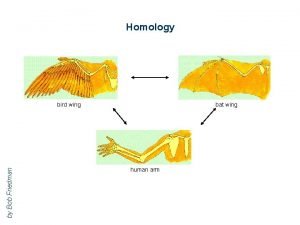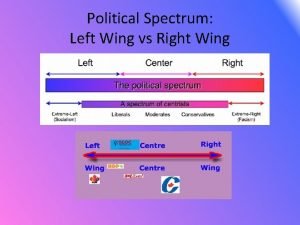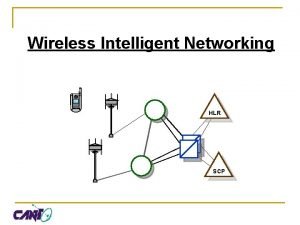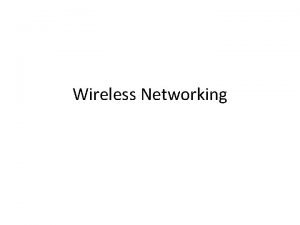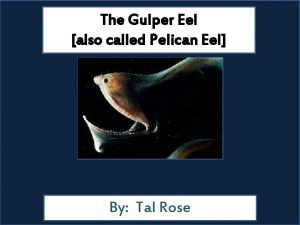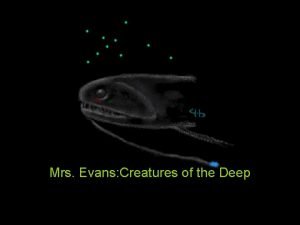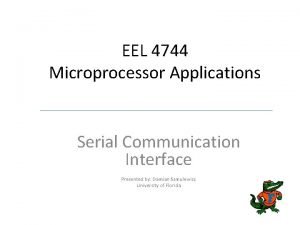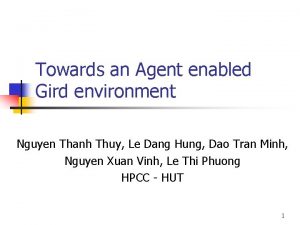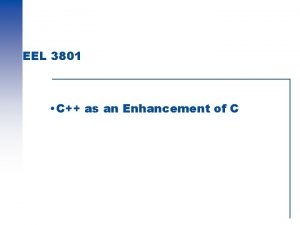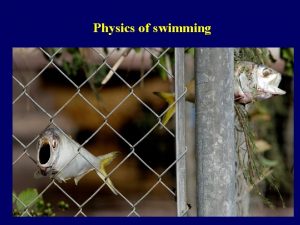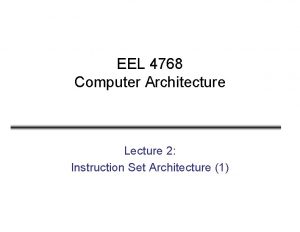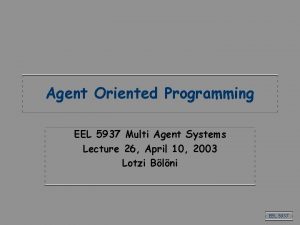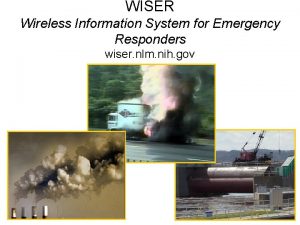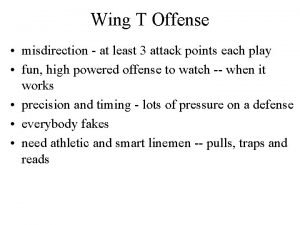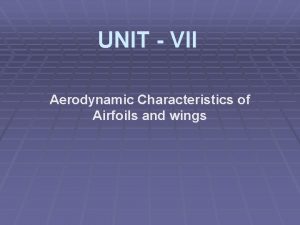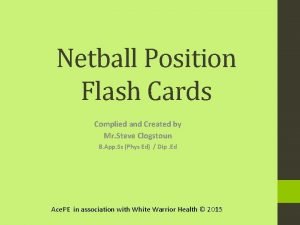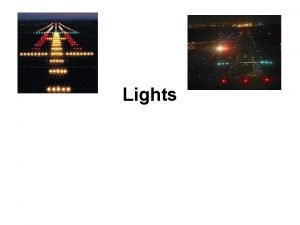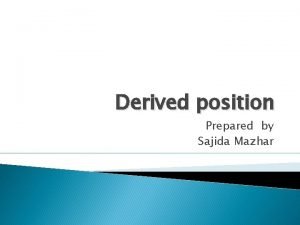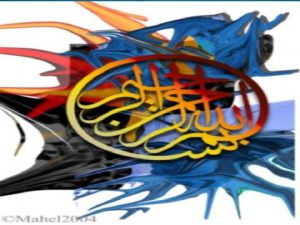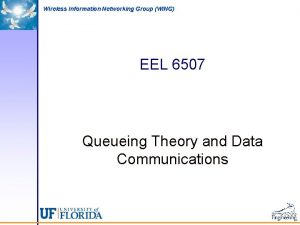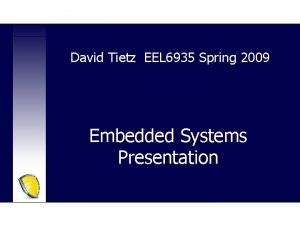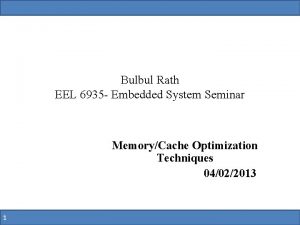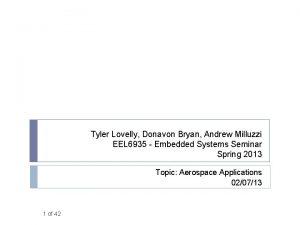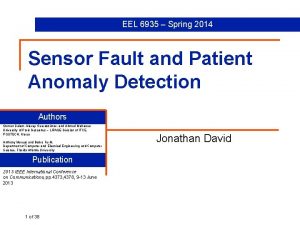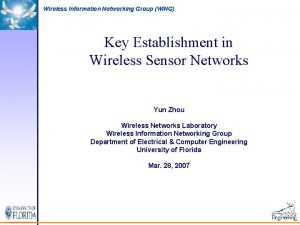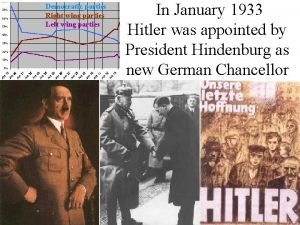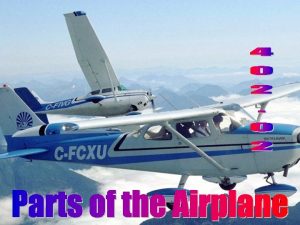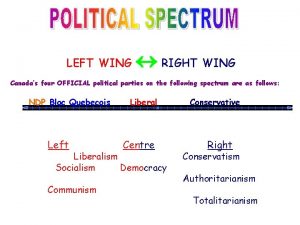Wireless Information Networking Group WING EEL 6935 Wireless

































![Wireless Information Networking Group (WING) Sender-Based “Autorate Fallback” • Auto-rate [Kamerman 97] • Active Wireless Information Networking Group (WING) Sender-Based “Autorate Fallback” • Auto-rate [Kamerman 97] • Active](https://slidetodoc.com/presentation_image_h2/e3534150087238f9f886f12d4950ef81/image-34.jpg)









- Slides: 43

Wireless Information Networking Group (WING) EEL 6935: Wireless Ad Hoc Networks Chapter 2: Medium Access Control (MAC)

Wireless Information Networking Group (WING) Outline • Introduction • Wireless MAC protocol – IEEE 802. 11 MAC and its variation • Performance analysis

Wireless Information Networking Group (WING) Wireless Medium Access Control (MAC)

Wireless Information Networking Group (WING) Wireless Medium Access Control (MAC) • Multiple communication devices directly communicate with each other via wireless medium • The medium is broadcast in nature: shared medium • Need coordination: one’s transmission will affect others • Medium Access Control (MAC): efficient way to coordinate the shared usage of the medium • Wireless MAC may affect protocol performance in high layers

Wireless Information Networking Group (WING) Medium Access Control (MAC) • Centralized vs distributed MAC • Centralized MAC – TDMA, FDMA, CDMA, SDMA – Centralized polling • Distributed MAC – Aloha and Slotted Aloha (Abramson, 1970 s) – CSMA/CD (Ethernet): the de facto standard for LANs • Our focus: IEEE 802. 11 MAC because of its popularity

Wireless Information Networking Group (WING) Wireless MAC • Coordinate the usage of the shared wireless medium – mitigate collisions – minimize the idle time B D C A

Wireless Information Networking Group (WING) CSMA/CA • Does Ethernet standard (CSMA/CD) work for wireless? • CSMA/CD does not work well in wireless channel – Difficult to detect collisions in a radio environment • Power level varies due to other factors such as fading – Difficult to control the wireless channel – Hidden and exposed terminal problems – Transceiver can only transmit or receive, but not both at the same time • CSMA/CA is used in wireless environments – – – Sense before transmit Contend for channel usage “Collision detection” via the acknowledgment Time-spacing to set access priority (CA) Avoid collisions via physical carrier sensing and virtual carrier sensing

Wireless Information Networking Group (WING) CSMA/CA • Carrier sensing mechanism – Physical layer carrier sensing: physical layer carries out the medium sensing (power sensing) – Virtual carrier sensing: each node monitors the Duration field in all MAC frames and place this information in the station’s Network Allocation Vector (NAV) if the value is greater than the current NAV value. The NAV acts like a timer to indicate that the medium is busy with transmissions from other nodes • Two operating modes – PCF mode: Point Coordination Function mode, access point (AP) coordinates the transmission – DCF mode: Distributed Coordination Function mode, also known as peer-to-peer mode, a contention-based operational mode

Wireless Information Networking Group (WING) CSMA/CA • Time-spacing – IFS: inter-frame space – SIFS: short IFS– providing highest priority level to access channel, e. g. , for ACK, CTS, the 2 nd or subsequent MSDU of a fragment burst – PIFS: PCF IFS, allowing PCF mode to take over – DIFS: DCF IFS, allowing DCF mode to operate

Wireless Information Networking Group (WING) CSMA/CA • Joining a network – After a station is turned on, it needs to determine whether another station or access point (AP) is present to join – Via a passive or active scanning mode – Receives the Service Set Identifier (SSID), Timing Synchronization Function, timer value, and PHY setup parameters from access point (AP) – Association process is carrying out – Authentication and privacy (or security) check

Wireless Information Networking Group (WING) CSMA/CA • DCF mode operation

Wireless Information Networking Group (WING) MAC • Sense before transmit: Choose a Backoff Time over the interval [0, CW] Backoff Time = Random() × a. Slot. Time • If the medium is idle for a backoff slot, the backoff time is decremented by a. Slot. Time • If the medium is determined to be busy during a backoff slot, the backoff procedure is suspended until the medium is determined to be idle for DIFS period • Whenever the Backoff Timer reaches zero, a packet transmission begins • Whenever the transmission is not successful (due to channel conditions or collisions via acknowledgment or timeout), the contention window size doubles and backoff timer is regenerated • Failure timer: if a node fails a number of times (say, 7), the node will stop transmission attempts and declare link failure.

Wireless Information Networking Group (WING) Binary Exponential Backoff

Wireless Information Networking Group (WING) Binary Exponential Backoff • Algorithm for delayed transmission: random period of time for all contention-based MAC • Binary exponential backoff algorithm: – Wnenver a transmission failure occurs, set current contention window size CW=2 CW (starting with CW=CWmin), pick random number from [0, CW], say, j, then set backoff time=j a. Time. Slot()

Wireless Information Networking Group (WING) A Problem • If a data frame DATA is long, a node that could not hear the transmission (hidden terminal problem) will attempt to transmit, resulting into a collision at the receiver DATA

Wireless Information Networking Group (WING) Multiple Access with Collision Avoidance (MACA) • RTS-CTS handshaking protocol – RTS: Request To Send – CTS: Clear To Send • Operations – sender sends RTS to receiver, any node hearing RTS will not transmit – receiver, upon the correct reception of RTS, will send CTS to the sender, any node hearing the CTS will refrain from transmission – regular data exchange starts after successful RTS-CTS exchange

Wireless Information Networking Group (WING) Distributed Foundation Wireless MAC (DFWMAC) • IEEE 802. 11 wireless LAN standard • RTS-CTS-DATA-ACK four-way handshake protocol (an option for 802. 11 family) • Operations – sender sensing the channel idle will wait for DIFS and then transmit RTS – receiver, upon receiving the RTS correctly, will wait for SIFS and then reply with CTS – sender, upon receiving CTS correctly, will wait for SIFS and transmit data – receiver will send ACK SIFS later after correct data – time spacing (DIFS>SIFS) provides priority to certain message – backoff algorithm will be used if collision

Wireless Information Networking Group (WING) IEEE 802. 11 MAC Protocol (Distributed) • CSMA/CA – Carrier sensing – Binary Exponential Backoff • Randomly chosen from [0, CW] • CW doubles in case of collision • Physical Carrier Sensing • Virtual Carrier Sensing – Interframe Spacing (IFS) • Short IFS (SIFS) < DCF IFS (DIFS) DIFS Request to send DATA RTS Transmitter A DATA SIFS Backoff CTS Receiver Clear to send B … Others ACK Acknowledgement DIFS ACK NAV(RTS) NAV(CTS) RTS Backoff …

Wireless Information Networking Group (WING) Distributed Foundation Wireless MAC (DFWMAC) • Collision resolution: backoff algorithm – IEEE 802. 11: binary exponential backoff • Any node involving in collisions (when the node does not receive the desired CTS for the transmitted RTS) will double the contention window size up to its maximum: i. e. , the node picks a random number between 0 and double of the previous window size for the next attempt – Fast collision resolution (FCR) algorithm (UF approach) • Upon collision, all nodes with data ready to transmit will expand their contention window size: i. e. , even the already deferred nodes will act again to actively avoid future collisions

Wireless Information Networking Group (WING) Fast Collision Resolution (FCR) • Re-examine 802. 11 – Each node starts with minimal contention window (CW): [0, CWmin], e. g. , 802. 11 DSSS CWmin=31 – Maximal contention window is [0, CWmax], e. g. , 802. 11 DSSS CWmax=1023 – A node with [0, CW] has transmission probability 1/(1+CW) – Each successful transmission will go back to use minimal CW, which implies that a node with successful transmission has high priority to transmit again in the following round of contention! – Nodes without data will not compete, so let nodes finish whenever seizing the channel may be a good thing! – Short-term unfairness

Wireless Information Networking Group (WING) Wasting Factors during Backoff • IDLE SLOTS : small # of active stations with large contention window size (ex, 2 stations in DSSS CWmin=31) • COLLISIONS : large # of active stations with small contention window size (ex, 50 stations in DSSS CWmin=7)

Wireless Information Networking Group (WING) Performance Problem • Problems: – Too many wasting idle slots when # of active stations is small – Rapid performance degradation when # of active stations is large too slow to resolve collisions • The common wisdom: finding the proper contention window size or the transmission probability – Optimal: p = 1/N, where N is the number of ready stations and p is the transmission probability – Estimating N dynamic tuning algorithm (Cali et al) – Difficult to estimate this number! • New idea: overcome the “future collisions”

Wireless Information Networking Group (WING) Performance Improvement • Analogy to the known ideas in the current research literature – Infostation: Transmit FAST only when the channel is good – Opportunistic scheduling: schedule transmission based on channel condition – IEEE 802. 11: select small backoff timer for nodes with successful transmissions – TCP congestion control: fast decrease window when congestion • Basic ideas for throughput improvement – Reduce the number of idle slots: fast backoff timer decrease – Resolve collisions quickly: actively back off – Increase the useful transmissions: statistically let a node dominate (transmit) whenever it seizes the transmission right – “Randomly loose” TDMA

Wireless Information Networking Group (WING) Fast Collision Resolution (FCR) • Solution – Large random backoff timer for the stations that are in deferring mode: redistribute all backoff timers to avoid “future collisions” • (YES, the deferring stations repick the backoff timers) – Small random backoff timer for the station with a successful packet transmission: let the channel efficiently used – Fast change of random backoff timers according to the status of transmissions/channel condition/station modes • Exponentially decreasing the backoff timers when a number of consecutive IDLE slots are detected – Control the fairness

Wireless Information Networking Group (WING) Fast Collision Resolution (FCR) Algorithm • Use much smaller initial (minimum) contention window size Min. CW than the IEEE 802. 11 MAC • Use much larger maximum contention window size Max. CW than the IEEE 802. 11 MAC • Increase the contention window size of a station when it is in either the collision state or the deferring state – deferring node: “backoff” when detecting the start of a busy period • Reduce the backoff timer exponentially fast when a prefixed # of consecutive idle slots are detected • Limit the number of successive packet transmissions to keep the fairness in check

Wireless Information Networking Group (WING) FCR: An Example • Min. CW = 3, Max. CW = 2047 • Fast Backoff Timer Reduction BTnew = BTold – a. Slot. Time (up to 7 idle slots) BTnew = BTold / 2 (after 7 idle slots) (e. g. , if BT=2047 slots, it is decreased by a. Slot. Time until it reaches 2040 slots at each idle backoff slots, after then, BT=1020 slots on the 8 th idle slot, 510 on the 9 th idle slot, 255 on the 10 th idle slot, and so on, until it either reaches zero or detects a non-idle slot) • Maximum limit of successive successful packet transmissions – To avoid the situation that a station dominates all packet transmission for a long period: If a station has performed maximum # of successive packet transmissions, it will change its contention window size to the maximum value to give opportunities for medium access to other stations

Wireless Information Networking Group (WING) Performance Evaluation • Network Configuration: IEEE 802. 11 DSSS

Wireless Information Networking Group (WING) Traffic Model • Source model – Saturated scenario: each station always has data to transmit (generate a packet whenever needed) – Packet length • Geometrically distributed: time unit is a slot – In less loaded scenario, Poisson arrivals are assumed

Wireless Information Networking Group (WING) Performance Evaluation • Throughput for 10 Best-Effort Data Stations

Wireless Information Networking Group (WING) Performance Evaluation • Throughput for 50 Best-Effort Data Stations

Wireless Information Networking Group (WING) Performance Evaluation • Throughput for 100 Best-Effort Data Stations

Wireless Information Networking Group (WING) Performance Evaluation • Throughput vs. the Offered Load

Wireless Information Networking Group (WING) Rate Adaptation • The original 802. 11 MAC was designed for one rate or at most transmit using one rate Packet Channel rate MPDU Phy
![Wireless Information Networking Group WING SenderBased Autorate Fallback Autorate Kamerman 97 Active Wireless Information Networking Group (WING) Sender-Based “Autorate Fallback” • Auto-rate [Kamerman 97] • Active](https://slidetodoc.com/presentation_image_h2/e3534150087238f9f886f12d4950ef81/image-34.jpg)
Wireless Information Networking Group (WING) Sender-Based “Autorate Fallback” • Auto-rate [Kamerman 97] • Active probing • Sender decreases bit rate after X consecutive transmission attempts fail – Transmission failure because of poor channel • Sender increases bit rate after Y consecutive transmission attempt succeed • Blind adaptation: simple but not efficient

Wireless Information Networking Group (WING) Rate Adaptation • Channel may change during the transmission of a data packet • Receiver-Based Auto. Rate (RBAR) MAC (Holland, Vaidya and Bahl, Mobi. Com’ 01) – Both side has to agree on the same rating scheme – Using RTS/CTS – RTS carries probing signal – Receiver receives the RTS and calculate the channel condition, e. g. , SNR – Receiver then sends CTS carrying the rating scheme – Transmitter uses the new rate to transmit the data packet

Wireless Information Networking Group (WING) Rate Adaptation • Problem with RBAR – May mess up with RTS/CTS virtual carrier sensing: a data packet may finish the transmission before NAV indicated in RTS • Opportunistic Auto Rate (OAR) MAC (Sadeghi, Kanodia, Sabharwal and Knightly, Mobi. Com’ 02) – Still want to follow 802. 11 virtual carrier sensing and maintain the time fairness nature in 802. 11 – Transmit multiple packets if channel is better after RTS/CTS handshake (squeezing in more bits within its own occupancy period)

Wireless Information Networking Group (WING) Rate Adaptation • Problem with RBAR and OAR – Follow 802. 11: segment the packet using one single rate • Adaptive segmentation (UF scheme) – Segment is generated only when MPDU is needed so that more bits may be packed in MPDU when channel is good while maintaining the same transmission time for MPDU at PHY layer – Segment bursts by actively deploying channel information for ack for the previous segment • Burst transmission: used in high data rate 802. 11 n

Wireless Information Networking Group (WING) Power Saving MAC • Power saving add-on (Mobi. Com’ 02) – Turn off the main radio when it does not transmit or receive – Add-on device is used to wake up the transceiver • Power controlled MAC (Mobi. Com’ 02) – High power for RTS/CTS while low power for data – Periodic high power transmission short burst during data transmission • Various sleeping scheduling algorithms – S-MAC: sensor MAC

Wireless Information Networking Group (WING) Quality of Service (Qo. S) • Different applications have different requirements – Delay and delay jitter (e. g. , real-time applications) – Throughput • Statistical Qo. S (prioritized service) guarantee at random MAC by – Time-spacing: higher priority traffic assigns shorter time-spacing for accessing the channel – Contention window size: higher priority traffic assigns smaller contention window size

Wireless Information Networking Group (WING) Quality of Service (Qo. S) • Black-burst scheme – Each node sends busy signal with appropriate length – The node with the longest period wins the channel – Real-time applications or highest priority traffic can be assigned the longest – Does not need to use the 802. 11 scheme!

Wireless Information Networking Group (WING) Quality of Service (Qo. S) • UF scheme (Kown, Fang and Latchman) – Reservation based – After a successful transmission, we reserve a time period: only real-time traffic (e. g. , voice) can access the channel; if nothing happens during this period, other data traffic can access right after the period – Real-time traffic accesses the medium using more smaller contention window size – Real-time traffic can reserve channel for later transmission – Similar to 802. 15. 3 scheme!

Wireless Information Networking Group (WING) IEEE 802. 11 e: Enhance Distributed Channel Access (EDCA) Mapping to Access Category (AC) Transmit queues Per-queue channel access function with internal collision resolution AIFS[0] AIFS[1] AIFS[2] AIFS[3] CW[0] CW[1] CW[2] CW[3]

Wireless Information Networking Group (WING) Medium Access Control (MAC) • IEEE 802. 11 family – 802. 11: 2 Mbps (2. 4 GHz) • Frequency hopping spread spectrum system • Direct Sequence Spread Spectrum system – – 802. 11 b: 11 Mbps, Wi-Fi tech (2. 4 GHz) 802. 11 a: 54 Mbps, OFDM tech (5. 5 GHz) 802. 11 e: Qo. S and back compatibility 802. 11 g: higher date rate (20+Mbps) in 2. 4 GHz band (unlicensed ISM band) • Wireless PAN (WPAN) – IEEE 802. 15 group – Similar MAC protocol to IEEE 802. 11 is used
 Bat wing bird wing
Bat wing bird wing Left vs right politics
Left vs right politics Sdn vs traditional network
Sdn vs traditional network Wireless intelligent networking
Wireless intelligent networking Wireless networking definition
Wireless networking definition Telecommunications the internet and wireless technology
Telecommunications the internet and wireless technology Information centric networking
Information centric networking The woman in black chapter 2
The woman in black chapter 2 Baby gulper eel
Baby gulper eel Gulper eel food
Gulper eel food Eel 3801 lab manual
Eel 3801 lab manual Eel gird
Eel gird Rahvusvahelised suhted
Rahvusvahelised suhted Eel 3705
Eel 3705 Estagio eel usp
Estagio eel usp Pelican eel adaptations
Pelican eel adaptations Moray eel and cleaner shrimp symbiotic relationship
Moray eel and cleaner shrimp symbiotic relationship C++ eel
C++ eel Simile challenge
Simile challenge Simile challenge
Simile challenge Physics of swimming
Physics of swimming Eel 4768
Eel 4768 Eel 4768
Eel 4768 I feel like a limp dishrag meaning
I feel like a limp dishrag meaning Eel sentence
Eel sentence Escola de eel
Escola de eel Eel 4712
Eel 4712 Eel programming language
Eel programming language Wiser artinya
Wiser artinya Wing t belly series
Wing t belly series Kill wing valve function
Kill wing valve function Airfoil characteristics
Airfoil characteristics Power pass football
Power pass football Wingover maneuver
Wingover maneuver Wing attack netball
Wing attack netball Cantilever wing
Cantilever wing Wing bar lights
Wing bar lights How are the whale flipper and the human arm different
How are the whale flipper and the human arm different Bat wing shape
Bat wing shape Ming dynasty social hierarchy
Ming dynasty social hierarchy Fallout standing position
Fallout standing position Process of curriculum development in pakistan
Process of curriculum development in pakistan Jeannette m. wing
Jeannette m. wing What type of tissue moves the chicken wing
What type of tissue moves the chicken wing
